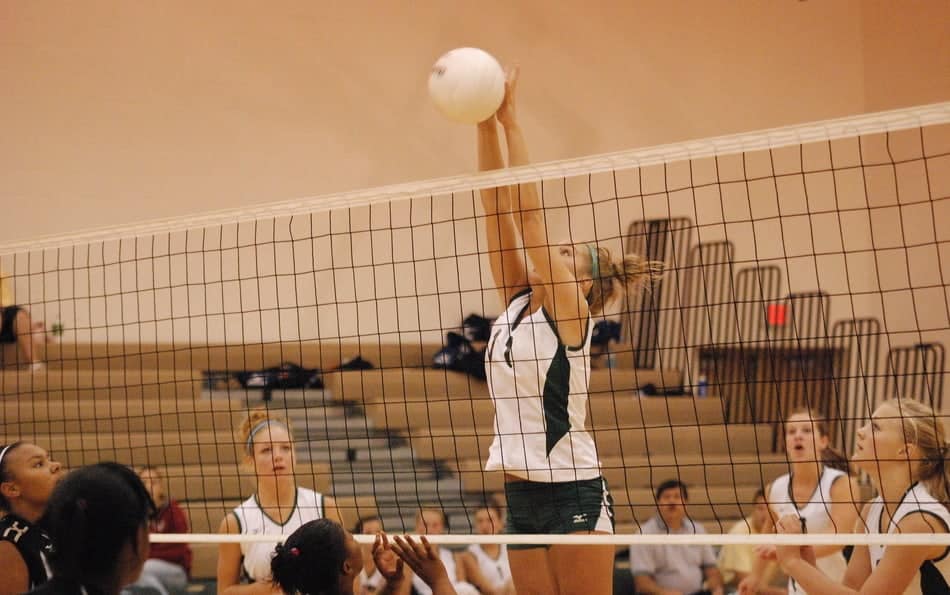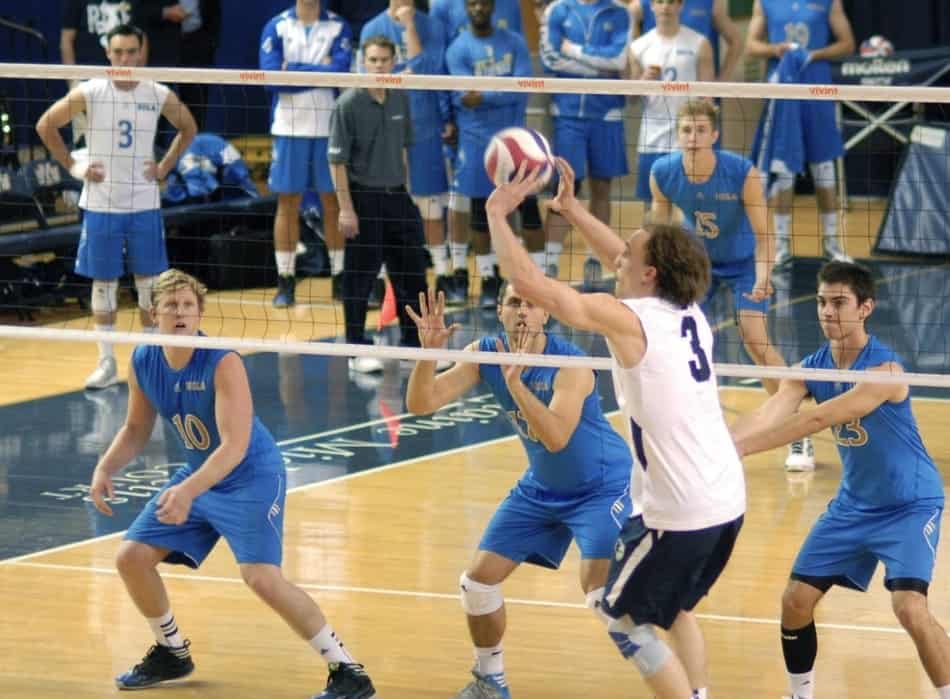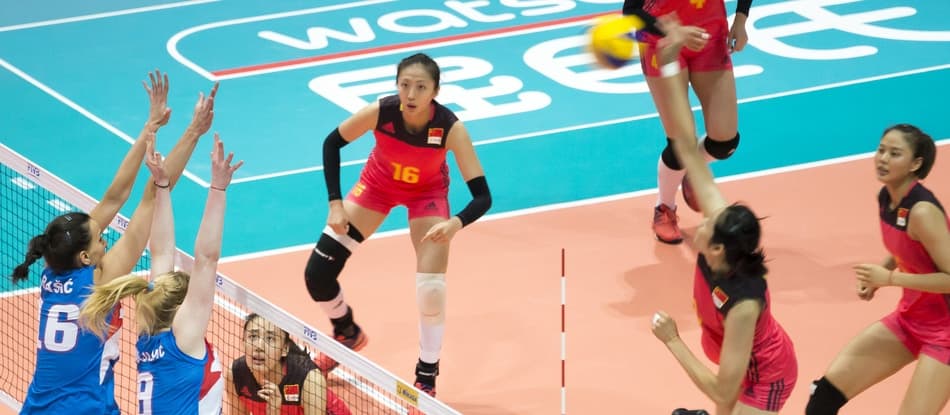Volleyball is a very exciting sport to watch, but it can be a little confusing for newcomers to figure out what’s going on and who is playing which position. If you’re not sure what the positions are and how to identify them, this article will help you grasp the ideas and concepts very easily. The true enjoyment of watching sports only comes when you really understand what’s going on and why; so take a moment and brush up on your volleyball knowledge and you’re sure to enjoy the next game all the more.
What Are The 6 Positions In Volleyball?
In alphabetical order, the 6 positions in volleyball are:
- Defensive specialist
- Libero
- Middle Blocker (also called Middle Hitter)
- Opposite Hitter (also called Right Side Hitter)
- Outside Hitter (also called Left Side Hitter)
- Setter
In the sections below, I dive into each position with a short description. It’s important to know that although you may be called one position, you may be asked from time to time, or even in every single game, to also play another role.
On each play, you will begin the play in your rotation (or at least following the rules of rotational order), but then throughout the rally, you may transition to your main location, the location that your position usually plays. Players have to be mindful if they are in the back row of the rotation, though they can play the ball up front, they are not allowed to block or attack the ball from in front of the attack line.
What is the Defensive Specialist Position in Volleyball?
Defensive specialist is probably the position you will hear about the least in the volleyball world. They don’t get a lot of attention because they often don’t stand out and not every team has someone who plays DS.
The defensive specialist is exactly what it sounds like: a player who specializes in playing defense. They play on the back row and usually substitute in and out replacing a front-row hitter.

Depending on the skills of the players at the other positions on the team, the libero often replaces 2 of the hitters that are the weakest defensive players. This can be the two middle blockers but doesn’t necessarily have to be them.
If a hitter is good at defense, the coach may choose for them to play all the way around the rotation, which would mean a defensive specialist may not be needed or not be needed as much. Some teams will use the libero to replace both middle or both 2 of the wing hitters, then the DS to replace only 1 of the others.
To learn all about defensive specialist, you can read this article called: Defensive Specialists In Volleyball.
What is the Role of a Volleyball Libero?
The libero is the most easily identified player on the court, they have a different colored jersey!
The libero is a special position that was created to make volleyball more competitive and entertaining. They are a purely defensive player that’s designed to counteract the high-powered offenses of great teams.
Before the libero role was added to volleyball, volleyball teams tended to have very offensive players who were sort of terrible at defense, and whoever got a good hit first usually won the rally. In today’s world, a good hit is not automatically going to be a kill.
The libero only plays on the back row because they are not allowed to be a part of the offense. The only legal way they can attack is from a hit that’s made where the ball is below the height of the net and the libero is behind the attack line.
The tradeoff is that while the libero doesn’t get to attack, they get to swap out at-will between any plays, for any player on the back row. Their substitutions are unlimited and they don’t have to wait for the referee to recognize them, they just transfer through the replacement zone (the entire sideline past the attack line) with the player they are trading off with.
Learn more about the libero position by reading: Master Guide To Liberos In Volleyball: Rules, Rotation, And Tips.
What is the Role of a Volleyball Middle Blocker or Middle Hitter?
While both of these names are correct, the one I hear the most often is called middle blocker. Whether you’re called a middle blocker or a middle hitter, don’t be confused, you’ll be doing both blocking and hitting! A lot of players or coaches will simply call them the “middle.”
The middle blocker is assigned to dominate the middle of the net. They will be the core of your team’s defense at the net and they can be a powerful force in the attack as well.

The middle blocker is often the tallest player(s) on the team, but that’s not necessarily required. What they need is the ability to dominate at the net both in the blocking game and the hitting. So the player needs to be able to elevate above the net, penetrate into the opponent’s airspace, and compete for the ball.
While they are often the tallest players, the truth is, a good middle needs to be able to jump with both good height and good timing. No matter how tall you are, being able to jump with height and good timing will amplify your game.
They also need to be fast so they can transition quickly and cover a lot of ground from side to side. After blocking, they only have a few seconds before they will need to be able to make their approach for an attack. The fact that they’re right up at the net all the time means they will have chances to scramble for misplayed shots, tips, and partial blocks.
Finally, they need fantastic skills at tracking the ball in open space. Countless points are won or lost when the ball is sent floating through the air and will come down near the net and the middle is usually the main player who can either block, tip, or attack the ball before anyone else has a chance.
To learn all about volleyball blocking, check out our article called: What Are the Different Types of Blocking in Volleyball?
What is the Opposite Hitter (or Right Side Hitter) Position in Volleyball?
The fact that the position is a “hitter” refers to that the main role is attacking from the front line. The Right Side Hitter is the one who plays the right side position of the front row. This position is also called the Opposite Hitter because it’s common for this hitter to line up in the opposite of the rotation as the setter.
Both left and right hitters may also be referred to as “wing hitters,” “wing spikers,” or “pin hitters” (the pin is the small pole that sticks up above the net along the sideline).
Even though you’re called a hitter, your role will also include blocking. Hitters block about as often as they hit, sometimes more often. This means when you’re in your preferred position and you look across the net, this will likely be the player you are competing with both on offense and defense for the majority of the game.
One thing that is unique about opposite hitters is because most teams prefer for their setter to operate from a spot between positions 2 and 3, the opposite hitter is right behind the setter most of the time. For this reason, if the opposite hitter has decent setting skills they often become the backup setter for when the setter has to make the first contact.
Want to improve your hitting? Check out our post called: 8 Fantastic Volleyball Hitting Drills and 2 Exercises
What is the Outside Hitter (or Left Side Hitter) Position in Volleyball?
The fact that the position is a “hitter” refers to that the main role is attacking from the front line. The Left Side Hitter is the one who plays the left side position of the front row. This position is also called the Outside Hitter because it is the furthest away from the setter, all the way outside.
Both left and right hitters may also be called “wing hitters,” “wing spikers,” or “pin hitters” (the pin refers to the small pole that sticks up above the net along the sideline).
Although you’re called a hitter, your role will also include blocking. Hitters block just as often as they hit, really probably more often. This means when you’re in your preferred position and you look across the net, this will likely be the player you are competing with both on offense and defense for the majority of the game.
What is the Role and Position of the Volleyball Setter?
The setter is often overlooked but is usually considered the most important role on the team. It may seem like they have an easy job and all they do is volley the ball while everyone else does the hard work, but looks can be deceiving.
The setter plays the second contact of the ball, so whoever receives the ball for your team will be trying to pass the ball to them. They take their position on the front row, near the net, and prepare to launch an attack.
While the hitters are very visible attacker who goes for the kill and scores the points, the setter is beside them calling the plays, then sending up the ball to the perfect spot. The setter is who makes it all happen.
To learn about what it really means to be a setter, check out: How to Set a Volleyball: A Beginner’s Guide.
What Do Position 1 through 6 Mean?
You may hear or see coaches calling position numbers out. The most common time is when a coach signals what position their player should serve to. It’s pretty common for coaches at the high school level and in the club setting, to signal a position number to their server.
If you divide 1 side of the court into a 6 square grid with 2 rows of 3, those are the 6 positions. They are numbered in the order in which players will serve.
So position number 1 is the server’s position in the back right corner. Then going to the front row, the right position is number 2 and following counter-clockwise, ends with the back middle position being number 6.
If this still seems a little confusing, I made this 4-minute video all about serving positions…
What Is The Most Important Position In Volleyball?
While every position is important on a volleyball team, some are more important than others, that’s just the way it is. While this is a matter of opinion and perspective, you want to know, right?
I believe the setter is the most important position and role to play on a volleyball team. The setter should be touching the ball every time it comes over to your side of the court. The offense flows through the hands of the setter.
In most cases, it will be the second contact which is to set up the attacker. If your setter is not playing well, it’s very challenging to score points as a team.

When the setter is given good passes to work with, they control and launch the attack that your team is going to mount against your opponents. They will use a variety of sets to try to catch the other team off-guard, execute your coach’s game plan, and influence whether you win the point or not.
If the setter isn’t making the second touch on the ball, it’s usually because they’ve either received or dug the ball, meaning someone else will have to touch the ball next. The only other reason for a setter not to be making contact is if your first contact was unsuccessful – it was either a shank, a freeball back over the net, or such a bad pass there’s no way the setter can get to it.
Which Volleyball Position Is The Hardest?
While every position in volleyball has its own challenges, some are more difficult than others. You could make a case for the setter being very difficult because of the stress and decision-making involved. Libero is very challenging because of the speed needed and physical wear and tear from all the digging and diving.
In my opinion, the middle blocker is the hardest position to play in volleyball. The middle has to be fully engaged throughout the rally. They need size to be a physical presence at the net, but they have to be fast to be effective. They are blocking, tipping, and hitting everywhere you look.
One benefit that most middle blockers have is that they usually trade out with the libero for the back row part of the rotation, so they are on the bench about half the game, which gives them a chance to recover and refresh. It really depends on the dynamics of your team, but often the libero and sometimes your setter will be in play continually, so this may make it an unfair comparison.

They also need to understand how to read the opposing team so that they can be in the right position to block effectively. Usually, the middle has by far the most opportunities to block which means they usually have the most opportunities to go after tips and react to partial blocks where the ball still ends up on your side of the net.
Would you like to shop for our favorite recommended player products? Choose the item below and click to shop on Amazon.
Photo Credits:
Feature image by Neon Tommy on flickr.com: https://creativecommons.org/licenses/by-sa/2.0/, cropped for size.
Defensive specialist image by K.M. Klemencic on flickr.com: https://creativecommons.org/licenses/by/2.0/
Middle blocker image by Rob Royce on flickr.com: https://creativecommons.org/publicdomain/mark/1.0/
Setter image by KLM volleyball on flickr.com: https://creativecommons.org/licenses/by/2.0/
Hardest position image by Jeffrey Ng on flickr.com: https://creativecommons.org/licenses/by-sa/2.0/, cropped to zoom.
Recent Posts
Athletes, listen up! Do you have a closet full of old jerseys, sweatpants, and tees that you just can't seem to part with? Well, dust them off, because you're sitting on a goldmine of fashion...
You may have heard, or you may have noticed, that there's been a change to the rule about double contact in volleyball. In 2022, an experimental rule change began to be implemented, where the double...
